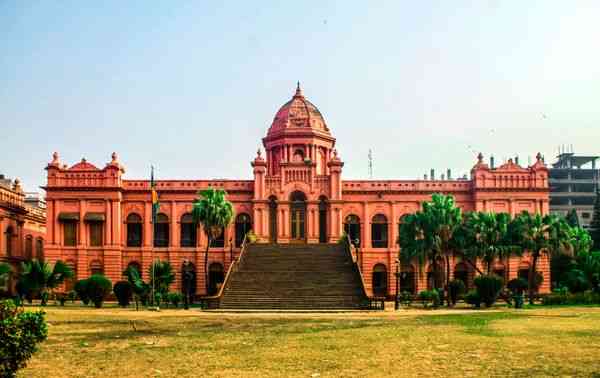Centuries when such, culture is like that then.
One civilization changes different kinds of cultures of the people. Many of us who are the people of this century may not be aware of the education, history, tradition, culture, manners of the people of our previous century. Today, five ancient and historical monuments of Bangladesh are presented in this article to give you a brief idea. So, let’s read this out and enjoy.
Paharpur Buddhist Bihar (Monastery)
Shat Gombuz Masjid (Sixty Domed Mosque)
Lalbagh Kella (Fort of Lalbagh)
Panam City
Ahsan Manzi
1. Paharpur Buddhist Bihar (Monastery)

The monastery was built in the late eighth or early ninth century by Sri
Dharmapala Dev, the second king of the Pala tribe. The locals call it Gopal Cheetah Hill, hence the name Paharpur, although its real name is Sompur Maha Bihar. Sir Alexander Cunningham discovered this magnificent structure in 1879 AD while visiting the Indian subcontinent in search of archeological artifacts. For 300 years, it was a famous Buddhist school for Buddhists. In view of this, followers from China, Tibet, Myanmar and Malaysia used to come to the Indian subcontinent and outside the subcontinent to acquire knowledge in this renowned Buddhist school. This is the largest Buddhist monastery in the world. In the tenth century AD, the eminent Pandit(Scholar) Atish Dipankar Srigyan was the Acharya (Chancellor) of this monastery.
2. Shat Gombuz Masjid (Sixty Domed Mosque)

This ancient mosque is located in Bagerhat district in the southern part of Bangladesh. The architecture of the mosque dates back to the 15th century. In ancient times it was not a mosque during the reign of Sultan Nasiruddin Mahmud Shah. Khan Al-Azam Ulug Khanjahan spent a lot of money and time to hold the meeting and built this Darbar(Kind of court) Sharif here. To enhance the beauty of the interior of the mosque, precious stones were brought from the state of Khalifabad and engraved on its walls. In the evolution of time, 60 domes became popular and sixty domes were named But surprisingly, the number of its domes is not sixty, but eighty one. This ancient mosque was declared a World Heritage Site by UNESCO in 1983.
3. Lalbagh Kella (Fort of Lalbagh)

Azam Shah, the 3rd prince of the Mughal emperor Aurangzeb in the 17th century, started the construction of the fort on the banks of the present Buriganga river in 1678 AD while he was the subedar of Bengal. During his tenure as subedar in Bengal, its construction was in full swing for 15 months. But when the Maratha rebellion started 15 months later, Emperor Aurangzeb summoned Azam Shah, the subedar of Bengal, to his Delhi court to suppress it. In the absence of the subedar, its construction was postponed before it was completed. Then came one of the subedars of Bengal at that time named Subadar Shahesta Khan. Shahesta Khan resumed the construction of this fort in 1784. But in the same year his daughter Iran Dukhat Rahmat Banur (Peri Bibi) died suddenly. On the death of her daughter, Isha Khan termed the fort as Apaya Fort and stopped the construction work. After the end of the Mughal period, it remained as an abandoned fort. Later the name of this area was changed from "Aurangabad" to "Lalbagh". Since then, the fort of Lalbagh has been named after the area.
4. Panam City

If you are looking for an ancient historical place in Bangladesh, this one’s great to visit. You will be surrounded with some beautiful historical villages which were built centuries ago. It was an important trading and political center of the fifteenth-century under the Begal ruler Isa khan.It’s about 30 KM far from the capital Dhaka. It consists of 52 nice old buildings in Panam city. The World Monument Fund published Panam Nagar in the list of 100 world-renowned historic installations in 2006. The old buildings were built with such an awesome architectural design. The artist's skills have been blended throughout by European and Mugals. It has covered 20 km area of Sonargaon. So far everything is concerned, it is one of the most visited tourist spots and archaeological attractive finds in Bangladesh.
5. Ahsan Manzil

Ahsan Manzil was the official residential palace and seat of the Nawab of Dhaka. It is located on the banks of the river Buriganga (now Islampur) in old Dhaka, known as Kumartuli in Islampur. This picturesque building is rich in impeccable decoration and is one of the best architectural monuments in Dhaka. The construction work of Ahsan Manzil started in 1859 AD and was completed in 1872 AD. Ahsan Manzil is a significant architectural monument of the country. The two-storey palace building on a 1 meter high altar has an area of 125.4 square meters in length and 26.5 square meters in width.Realizing the historical and architectural significance of Ahsan Manzil, the Bangladesh government took the initiative to renovate the building and turn it into a museum. Later on, it was designated as a national museum.


